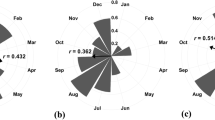Abstract
Thebirth season of Formosan macaqueM. cyclopis during our study started in February and ended in August with a peak in the second half of April and the first half of May. The average birth rate was 82%±21 for 114 females with four years of breeding records. Our study reports that a time span of one year between births can be considered as the norm for the wildM. cyclopis. Of the 288 inter-birth intervals (IBI), 88.5% showed a 1-year interval (mean 364±SD 29 days); 11% showed 2-year interval (727±36 days); and 1% (2 females) had 3-year interval (range 1030–1040 days). The IBI for females that had infant loss within six months of life were the shortest. But there was no significant difference from that of females that had stillbirth (p>0.9) and infant that survived for first six months of life (p>0.06). However, among 255 cases of 1-year IBI, stillbirth or following infant loss within six months of life did significantly shorten IBI for ten days (F 1,253=5.74,p<0.05).
Similar content being viewed by others
References
Altmann, J., 1974. Observational study of behavior: sampling methods.Behaviour 49: 227–265.
Altmann, J.;Altmann, S. A.;Hausfater, G. 1978. Primate infant's effect on mother's future reproduction.Science, 201: 1028–1029.
Bitetti, M. S.;Janson, C. H. 2000. When will the stork arrive?: patterns of birth seasonality in Neotropical primates.Amer. J. Primatol., 50: 109–130.
Cozzolino, R.;Cordischi, C.;Aureli, F.;Scucchi, S. 1992. Environmental temperature and reproductive seasonality in Japanese macaques (Macaca fuscata).Primates, 33: 329–336.
Dien, Z. M. 1985. The Formosan rock-monkey.Quert. J. Taiwan Mus., 11: 345–348.
Dixson A. F. 1998.Primate Sexuality: Comparative Studies of the Prosimians, Monkeys, Apes, and Human Beings, Oxford Univ. Press, London.
Drickamer, L. C. 1974. A ten-year summary of reproductive data for free-rangingMacaca mulatta.Folia Primatol., 21: 61–80.
Fedigan, L. M. 1983. Dominance and reproductive success in primates.Ybk. Phys. Anthropol., 26: 91–129.
Frawley, L. S.;Mulchahey, J. J.;Neill, J. D. 1983. Nursing induces a biphasic release of prolactin in rhesus monkeys.Endocrinol., 112: 558–561.
Frisch, R. E. 1978. Population, food intake, and fertility.Science, 199: 22–30.
Harcourt, A. H. 1987. Dominance and fertility among female primatesJ. Zool. Lond., 213: 471–487.
Hendrie, T. A.;Peterson, P. E.;Short, J. J.;Tarantal, A. F.;Rothgaran, E.;Hendrie, M. I.;Hendrickx, A. G. 1996. Frequency of prenatal loss in a macaque breeding colony.Amer. J. Primatol., 40: 41–53.
Hsu, M. J.;Lin, J. F.;Agoramoorthy, G. 2000. Occurrence of twins among wild troops of Formosan macaquesMacaca cyclopis at Mt. Longevity, Taiwan.Folia Primatol., 71: 154–156.
IUCN. 1996The 1996 IUCN Red List of Threatened Animals. Gland: IUCN.
Kawamura, S.;Norikoshi, K.;Azuma, N. 1991. Observation of Formosan monkeys (Macaca cyclopis) in Taipingshan, Taiwan, In:Primatology Today,Ehara A.;Kimura,T.;Takenaka,O.;Iwamoto,M. (eds.), Elsevier, Amsterdam, pp. 97–100.
Keverne, E. B.;Michael, R. P. 1970. Annual changes in the menstruation of rhesus monkey.J. Endocrinol., 48: 669–670.
Lee, L. L.;Lin, Y. S. 1991. Status of Formosan macaques in Taiwan. In:Primatology Today,Ehara,A.;Kimura,T.;Takenaka,O.;Iwamoto,M. (eds.), Elsevier, Amsterdam, pp. 33–36.
Lee, L. L.;Lin, Y. S. 1995. Status of Formosan macaques in Taiwan.Primate Conserv., 11: 18–20.
Masui, K.;Narita, Y.;Tanaka, S. 1986. Information on the distribution of Formosan monkeys (Macaca cyclopis).Primates, 27: 383–392.
Nadler, R. D.;Graham, C. E.;Collins, D. C.;Kling, O. R. 1981. Postpartum amenorrhea and behavior of apes. In:Reproductive Biology of the Great Apes,Graham,C. E. (ed.), Academic Press, London, pp. 69–81.
Paul, A.;Thommen, D. 1984. Timing of birth, female reproductive success and infant sex ratio in semifree-ranging barbary macaques (Macaca sylvanus).Folia Primatol., 42: 2–16.
Peng, M.-T.;Lai, Y.-L.;Yang, C.-S.;Chiang, H.-S.;New, A. E.;Chang, C.-P. 1973. Reproductive parameters of the Taiwan monkey (Macaca cyclopis).Primates, 14: 201–213.
Petto, A. J.;la Reau-Alves, M. N.;Ellison, P. T.;Abbruzzese, M. C. 1995. Reproduction in captive Taiwan macaques (Macaca cyclopis), in comparison to other common macaque species.Zoo Biol. 14: 331–346.
Rawlins, R. G.;Kessler, M. J. 1986.The Cayo Santiago Macaques History; Behavior and Biology. State Univ. of New York Press, Albany.
SAS Institute. 1989.SAS/FSP Software, Usage and Reference: Version 6. SAS Institute, Cary, North Carolina.
Scucchi, S. 1984. Interbirth intervals in a captive group of Japanese macaques.Folia Primatol., 42: 203–208.
Takahata, Y.;Suzuki, S.;Agetsuma, N.;Okayasu, N.;Sugiura, H.;Takahashi, H.;Yamagiwa, J.;Izawa, K.;Furuichi, T.;Hill, D. A.;Maruhashi, T.;Saito, C.;Sato, S.;Sprague, D. S. 1998 Reproduction of wild Japanese macaque females of Yakushima and Kinkazan Islands: a preliminary report.Primates, 39: 339–349.
Tanaka, S. 1986. Further note on the distribution problems of the Formosan monkey (Macaca cyclopis).Kyoto Univ. Overseas Res. Report of Studies on Nonhuman Primates, 5: 95–104.
Tanaka, T.;Tokuda, K.;Kotera, S. 1970. Effects of infant loss on the interbirth interval of Japanese monkeys.Primates, 11: 113–117.
Valerio, D. A.;Miller, R. L.;Innes, R. M.;Coutney, K. D.;Pallotta A. J.;Guttmacher, R. M. 1969. Macaca mulatta:Management of a Laboratory Breeding Colony Academic Press, New York.
WCL. 1989.Republic of China's Wildlife Conservation Law I-3266. Taipei, Taiwan, ROC.
Wolfe, L. D. 1986. Reproductive biology of rhesus and Japanese macaques.Primates, 27: 95–102.
Wu, H.-Y.;Lin, Y.-S. 1992. Life history variables of wild troops of Formosan macaques (Macaca cyclopis) in Kenting, Taiwan.Primates, 33: 85–97.
Wu, H.-Y.;Lin, Y.-S. 1993. Seasonal variation of the activity and range use patterns of a wild troop of Formosan macaque in Kenting, Taiwan.Bull. Inst. Zool., 32: 242–252.
Zhao, Q. K. 1994. Birth timing shift with altitude and its ecological implication forMacaca thibetana at Mt. Emei.Oecologia Montana, 3: 24–26.
Author information
Authors and Affiliations
Corresponding author
About this article
Cite this article
Hsu, M.J., Agoramoorthy, G. & Lin, JF. Birth seasonality and interbirth intervals in free-ranging formosan macaques,Macaca cyclopis, at Mt. Longevity, Taiwan. Primates 42, 15–25 (2001). https://doi.org/10.1007/BF02640685
Received:
Accepted:
Issue Date:
DOI: https://doi.org/10.1007/BF02640685




